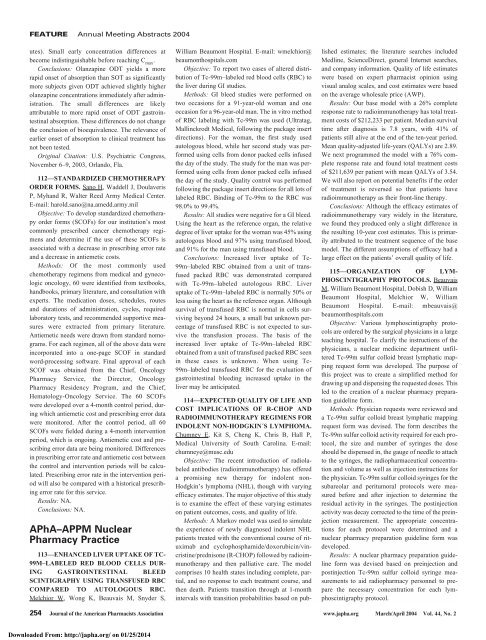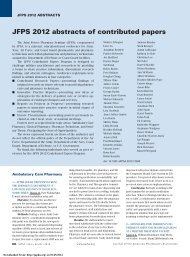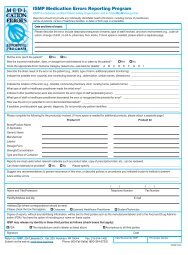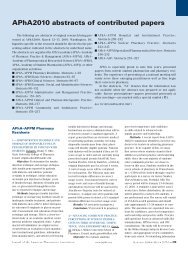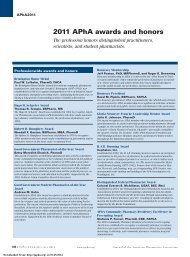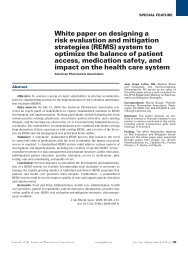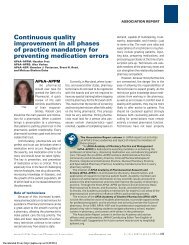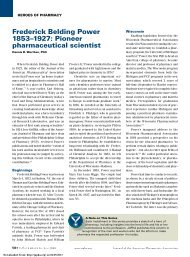Downloaded - Journal of American Pharmacists Association
Downloaded - Journal of American Pharmacists Association
Downloaded - Journal of American Pharmacists Association
You also want an ePaper? Increase the reach of your titles
YUMPU automatically turns print PDFs into web optimized ePapers that Google loves.
FEATURE Annual Meeting Abstracts 2004<br />
utes). Small early concentration differences at<br />
become indistinguishable before reaching C max<br />
.<br />
Conclusions: Olanzapine ODT yields a more<br />
rapid onset <strong>of</strong> absorption than SOT as significantly<br />
more subjects given ODT achieved slightly higher<br />
olanzapine concentrations immediately after administration.<br />
The small differences are likely<br />
attributable to more rapid onset <strong>of</strong> ODT gastrointestinal<br />
absorption. These differences do not change<br />
the conclusion <strong>of</strong> bioequivalence. The relevance <strong>of</strong><br />
earlier onset <strong>of</strong> absorption to clinical treatment has<br />
not been tested.<br />
Original Citation: U.S. Psychiatric Congress,<br />
November 6–9, 2003, Orlando, Fla.<br />
112—STANDARDIZED CHEMOTHERAPY<br />
ORDER FORMS. Sano H, Waddell J, Doulaveris<br />
P, Myhand R, Walter Reed Army Medical Center.<br />
E-mail: harold.sano@na.amedd.army.mil<br />
Objective: To develop standardized chemotherapy<br />
order forms (SCOFs) for our institution’s most<br />
commonly prescribed cancer chemotherapy regimens<br />
and determine if the use <strong>of</strong> these SCOFs is<br />
associated with a decrease in prescribing error rate<br />
and a decrease in antiemetic costs.<br />
Methods: Of the most commonly used<br />
chemotherapy regimens from medical and gynecologic<br />
oncology, 60 were identified from textbooks,<br />
handbooks, primary literature, and consultation with<br />
experts. The medication doses, schedules, routes<br />
and durations <strong>of</strong> administration, cycles, required<br />
laboratory tests, and recommended supportive measures<br />
were extracted from primary literature.<br />
Antiemetic needs were drawn from standard nomograms.<br />
For each regimen, all <strong>of</strong> the above data were<br />
incorporated into a one-page SCOF in standard<br />
word-processing s<strong>of</strong>tware. Final approval <strong>of</strong> each<br />
SCOF was obtained from the Chief, Oncology<br />
Pharmacy Service, the Director, Oncology<br />
Pharmacy Residency Program, and the Chief,<br />
Hematology-Oncology Service. The 60 SCOFs<br />
were developed over a 4-month control period, during<br />
which antiemetic cost and prescribing error data<br />
were monitored. After the control period, all 60<br />
SCOFs were fielded during a 4-month intervention<br />
period, which is ongoing. Antiemetic cost and prescribing<br />
error data are being monitored. Differences<br />
in prescribing error rate and antiemetic cost between<br />
the control and intervention periods will be calculated.<br />
Prescribing error rate in the intervention period<br />
will also be compared with a historical prescribing<br />
error rate for this service.<br />
Results: NA.<br />
Conclusions: NA.<br />
APhA–APPM Nuclear<br />
Pharmacy Practice<br />
113—ENHANCED LIVER UPTAKE OF TC-<br />
99M–LABELED RED BLOOD CELLS DUR-<br />
ING GASTROINTESTINAL BLEED<br />
SCINTIGRAPHY USING TRANSFUSED RBC<br />
COMPARED TO AUTOLOGOUS RBC.<br />
Melchior W, Wong K, Beauvais M, Snyder S,<br />
William Beaumont Hospital. E-mail: wmelchior@<br />
beaumonthospitals.com<br />
Objective: To report two cases <strong>of</strong> altered distribution<br />
<strong>of</strong> Tc-99m–labeled red blood cells (RBC) to<br />
the liver during GI studies.<br />
Methods: GI bleed studies were performed on<br />
two occasions for a 91-year-old woman and one<br />
occasion for a 96-year-old man. The in vitro method<br />
<strong>of</strong> RBC labeling with Tc-99m was used (Ultratag,<br />
Mallinckrodt Medical, following the package insert<br />
directions). For the woman, the first study used<br />
autologous blood, while her second study was performed<br />
using cells from donor packed cells infused<br />
the day <strong>of</strong> the study. The study for the man was performed<br />
using cells from donor packed cells infused<br />
the day <strong>of</strong> the study. Quality control was performed<br />
following the package insert directions for all lots <strong>of</strong><br />
labeled RBC. Binding <strong>of</strong> Tc-99m to the RBC was<br />
98.0% to 99.4%.<br />
Results: All studies were negative for a GI bleed.<br />
Using the heart as the reference organ, the relative<br />
degree <strong>of</strong> liver uptake for the woman was 45% using<br />
autologous blood and 97% using transfused blood,<br />
and 91% for the man using transfused blood.<br />
Conclusions: Increased liver uptake <strong>of</strong> Tc-<br />
99m–labeled RBC obtained from a unit <strong>of</strong> transfused<br />
packed RBC was demonstrated compared<br />
with Tc-99m–labeled autologous RBC. Liver<br />
uptake <strong>of</strong> Tc-99m–labeled RBC is normally 50% or<br />
less using the heart as the reference organ. Although<br />
survival <strong>of</strong> transfused RBC is normal in cells surviving<br />
beyond 24 hours, a small but unknown percentage<br />
<strong>of</strong> transfused RBC is not expected to survive<br />
the transfusion process. The basis <strong>of</strong> the<br />
increased liver uptake <strong>of</strong> Tc-99m–labeled RBC<br />
obtained from a unit <strong>of</strong> transfused packed RBC seen<br />
in these cases is unknown. When using Tc-<br />
99m–labeled transfused RBC for the evaluation <strong>of</strong><br />
gastrointestinal bleeding increased uptake in the<br />
liver may be anticipated.<br />
114—EXPECTED QUALITY OF LIFE AND<br />
COST IMPLICATIONS OF R-CHOP AND<br />
RADIOIMMUNOTHERAPY REGIMENS FOR<br />
INDOLENT NON-HODGKIN´S LYMPHOMA.<br />
Chumney E, Kit S, Cheng K, Chris B, Hall P,<br />
Medical University <strong>of</strong> South Carolina. E-mail:<br />
chumneye@musc.edu<br />
Objective: The recent introduction <strong>of</strong> radiolabeled<br />
antibodies (radioimmunotherapy) has <strong>of</strong>fered<br />
a promising new therapy for indolent non-<br />
Hodgkin’s lymphoma (NHL), though with varying<br />
efficacy estimates. The major objective <strong>of</strong> this study<br />
is to examine the effect <strong>of</strong> these varying estimates<br />
on patient outcomes, costs, and quality <strong>of</strong> life.<br />
Methods: A Markov model was used to simulate<br />
the experience <strong>of</strong> newly diagnosed indolent NHL<br />
patients treated with the conventional course <strong>of</strong> rituximab<br />
and cyclophosphamide/doxorubicin/vincristine/prednisone<br />
(R-CHOP) followed by radioimmunotherapy<br />
and then palliative care. The model<br />
comprises 10 health states including complete, partial,<br />
and no response to each treatment course, and<br />
then death. Patients transition through at 1-month<br />
intervals with transition probabilities based on published<br />
estimates; the literature searches included<br />
Medline, ScienceDirect, general Internet searches,<br />
and company information. Quality <strong>of</strong> life estimates<br />
were based on expert pharmacist opinion using<br />
visual analog scales, and cost estimates were based<br />
on the average wholesale price (AWP).<br />
Results: Our base model with a 26% complete<br />
response rate to radioimmunotherapy has total treatment<br />
costs <strong>of</strong> $212,233 per patient. Median survival<br />
time after diagnosis is 7.8 years, with 41% <strong>of</strong><br />
patients still alive at the end <strong>of</strong> the ten-year period.<br />
Mean quality-adjusted life-years (QALYs) are 2.89.<br />
We next programmed the model with a 76% complete<br />
response rate and found total treatment costs<br />
<strong>of</strong> $211,639 per patient with mean QALYs <strong>of</strong> 3.54.<br />
We will also report on potential benefits if the order<br />
<strong>of</strong> treatment is reversed so that patients have<br />
radioimmunotherapy as their front-line therapy.<br />
Conclusions: Although the efficacy estimates <strong>of</strong><br />
radioimmunotherapy vary widely in the literature,<br />
we found they produced only a slight difference in<br />
the resulting 10-year cost estimates. This is primarily<br />
attributed to the treatment sequence <strong>of</strong> the base<br />
model. The different assumptions <strong>of</strong> efficacy had a<br />
large effect on the patients’ overall quality <strong>of</strong> life.<br />
115—ORGANIZATION OF LYM-<br />
PHOSCINTIGRAPHY PROTOCOLS. Beauvais<br />
M, William Beaumont Hospital, Dobish D, William<br />
Beaumont Hospital, Melchior W, William<br />
Beaumont Hospital. E-mail: mbeauvais@<br />
beaumonthospitals.com<br />
Objective: Various lymphoscintigraphy protocols<br />
are ordered by the surgical physicians in a large<br />
teaching hospital. To clarify the instructions <strong>of</strong> the<br />
physicians, a nuclear medicine department unfiltered<br />
Tc-99m sulfur colloid breast lymphatic mapping<br />
request form was developed. The purpose <strong>of</strong><br />
this project was to create a simplified method for<br />
drawing up and dispensing the requested doses. This<br />
led to the creation <strong>of</strong> a nuclear pharmacy preparation<br />
guideline form.<br />
Methods: Physician requests were reviewed and<br />
a Tc-99m sulfur colloid breast lymphatic mapping<br />
request form was devised. The form describes the<br />
Tc-99m sulfur colloid activity required for each protocol,<br />
the size and number <strong>of</strong> syringes the dose<br />
should be dispensed in, the gauge <strong>of</strong> needle to attach<br />
to the syringes, the radiopharmaceutical concentration<br />
and volume as well as injection instructions for<br />
the physician. Tc-99m sulfur colloid syringes for the<br />
subareolar and peritumoral protocols were measured<br />
before and after injection to determine the<br />
residual activity in the syringes. The postinjection<br />
activity was decay corrected to the time <strong>of</strong> the preinjection<br />
measurement. The appropriate concentrations<br />
for each protocol were determined and a<br />
nuclear pharmacy preparation guideline form was<br />
developed.<br />
Results: A nuclear pharmacy preparation guideline<br />
form was devised based on preinjection and<br />
postinjection Tc-99m sulfur colloid syringe measurements<br />
to aid radiopharmacy personnel to prepare<br />
the necessary concentration for each lymphoscintigraphy<br />
protocol.<br />
254 <strong>Journal</strong> <strong>of</strong> the <strong>American</strong> <strong>Pharmacists</strong> <strong>Association</strong> www.japha.org March/April 2004 Vol. 44, No. 2<br />
<strong>Downloaded</strong> From: http://japha.org/ on 01/25/2014


